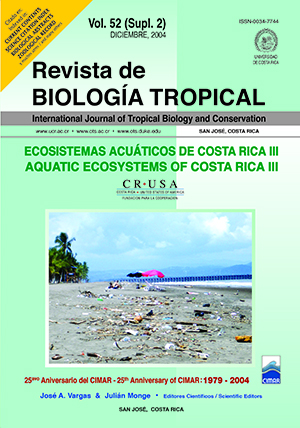Resumen
Entre los años 2000 a 2002 se recolectaron y se analizaron 130 muestras de agua de mar en las costas de Costa Rica, para determinarles la concentración de hidrocarburos de petróleo disueltos y dispersos (HPDD), referida a equivalentes de criseno en hexano, y expresada como μg·L-1. Se utilizó la técnica analítica de fluorescencia molecular. 42 muestras correspondieron al Caribe (Moín) y 81 al Pacífico (Bahía Culebra, Golfo de Nicoya, Golfo Dulce y en una ocasión se tomaron muestras a lo largo del Estero de Puntarenas). En la zona costera de Moín el promedio de la concentración de HPDD fue 0.10 μg·L-1, con una desviación estándar de ± 0.18 μg·L-1, en un ámbito desde concentraciones no detectables por el método, (nd), hasta 0.65 μg·L-1. En el Pacífico las concentraciones para todo el período del estudio, estuvieron entre nd y 0.37 μg·L-1. En la Bahía Culebra no se detectaron HPDD en ninguna de las muestras (n = 12); en el Golfo de Nicoya el promedio y la desviación estándar fueron 0.04 μg·L-1 ± 0.09 μg·L-1 (n = 51), en un ámbito desde nd hasta 0.33 μg·L-1. En el Golfo Dulce el promedio y la desviación estándar fueron 0.05 μg·L-1 ± 0.11 μg·L-1 (n = 18), en el ámbito desde nd a 0.37 μg·L-1. Durante las fechas en que se llevó a cabo el muestreo, no se encontró una situación de contaminación por petróleo en los ecosistemas costeros estudiados, puesto que las concentraciones de HPDD no rebasaron el límite de 10 μg·L-1 referido a equivalentes de criseno, considerado típico de áreas oceánicas contaminadas. En Bahía Culebra fue la primera vez que se hizo el estudio de la contaminación por petróleo y se comprobó que en las fechas de muestreo la zona estuvo libre de esta contaminación. El promedio y la desviación estándar en el Estero de Puntarenas fueron 1.21 μg·L-1 ± 2.10 μg·L-1 (n = 7), en un ámbito de 0.17 a 5.91 μg·L-1. Estos resultados evidenciaron una situación de contaminación moderada y la naturaleza estuarina de este cuerpo de agua costera, que distribuye irregularmente los HPDD descargados en ella.Citas
Acuña, J.A. 1993. Contaminación por petróleo en la costa Caribe de Costa Rica. In: El manejo de ambientes y recursos costeros de América Latina y el Caribe. Publicación del Departamento de Asuntos Científicos y Tecnológicos de la Organización de los Estados Americanos. Volumen 2:153-161. Washington D.C. Octubre 1993.
Acuña, J.A. & M.M. Murillo. 1987. Contaminación por hidrocarburos de petróleo en la Isla del Caño. Ing. Cienc. Quím. 11(4):95-98.
Al-Lihaibi, S.S. & S. J. Ghazi. 1997. Hydrocarbon distributions in sediments of the open area of the Arabian Gulf following the 1991 Gulf War oil spill. Mar. Pollut. Bull. 34(11):941-948.
Botello, A.V., G. Ponce-Vélez, A. Toledo, G. Díaz-González & S. Villanueva. 1996. Ecología, recursos costeros y contaminación en el Golfo de México, p 25-44. In Botello, A.V., J.L. Rojas-Galaviz, J.A. Benitez, D. Zárate-Lomelí (Eds). Golfo de México, Contaminación e Impacto Ambiental: Diagnóstico y Tendencias. Universidad Autónoma de Campeche. EPOMEX Serie científica 5. 667 pp.
Burns, K.A. 1993. Hydrocarbon Chemistry. In Keller, B.D., and J.B.C. Jackson, eds. 1993. Long-term assessment of the oil spill at Bahía Las Minas, Panama, synthesis report, Volume II: technical report. OCS Study MMS 93-0048. U.S. Department of the Interior, Minerals Management Service, Gulf of México OCS Region, New Orleans, La. 1017 pp.
Clark, R.B. 2001. Marine Pollution. Fifth edition. Oxford University Press. p. 64–97.
Córdoba-Muñoz, R. 1998. Primary productivity in the water column of Estero Morales, a mangrove system in the Gulf of Nicoya, Costa Rica. Rev. Biol. Trop. 46 (Supl. 6): 257-262.
Guzmán, H.M., J.B.C. Jackson & E. Weil. 1991. Shortterm ecological consequences of a major oil spill on Panamanian subtidal reef corals. Coral Reefs 10: 1-12.
IOC-UNESCO. 1984. Manual for monitoring oil and dissolved / dispersed petroleum hydrocarbons in marine waters and on beaches, Intergovernmental Oceanographic Commission. Manuals and Guides No. 13. UNESCO, Paris. 35 p.
Keller, B.D., J.B.C. Jackson, J.D. Cubit, S.D. Garrity & H.M. Guzmán. 1 Introduction. In Keller, B.D., and J.B.C. Jackson, eds. 1993. Long-term assessment of the oil spill at Bahía Las Minas, Panama, synthesis report, volume II: technical report. OCS Study MMS 93-0048. U.S. Department of the Interior, Minerals Management Service, Gulf of México OCS Region, New Orleans, La. 1 017 pp.
Kornilios, S., P.G. Drakopoulos & C. Dounas. 1998. Pelagic tar, dissolved/dispersed petroleum hydrocarbons and plastic distribution in the Cretan Sea, Greece. Mar. Pollut. Bull., 36(12): 989-993.
Lee, R.F. & D.S. Page. 1997. Petroleum hydrocarbons and their effects in subtidal regions after major oil spills. Mar. Pollut. Bull. 34(11): 928-940.
Levy, E.M, M. Ehrhardt, D. Kohnke, E. Sobtchenko, T. Suzoku & A. Tokuhiro. 1981. Global Oil Pollution. Results of MAPMOPP, the IGOSS Pilot Project on Marine Pollution (Petroleum) Monitoring IOC, 39 pp.
Mata, A., J.A. Acuña, M.M. Murillo y J. Cortés. 1987. La contaminación por petróleo en el Caribe de Costa Rica: 1981-1985. Caribb. J. Sci, 23: 41-49.
Meier, P.C. & R.E. Zünd. (1993). Statistical methods in Analytical Chemistry. John Wiley & Sons, Inc. New York.
Refinadora Costarricense de Petróleo (Recope). 2004. Página web: www.recope.go.cr
Zanardi, E., M. Caruso-Bícego & R.R. Weber. 1999. Dissolved/ dispersed petroleum aromatic hydrocarbons in the São Sebastião Channel, São Paulo, Brazil. Mar. Pollut. Bull. 38(5): 410-413.
##plugins.facebook.comentarios##

Esta obra está bajo una licencia internacional Creative Commons Atribución 4.0.
Derechos de autor 2004 Revista de Biología Tropical


